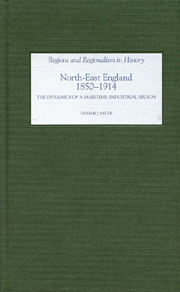Book contents
- Frontmatter
- Contents
- Dedication
- List of illustrations
- Preface
- 1 The North East in time and space
- 2 Horizons: ports, trade and mobility
- 3 Hinterlands and industrial districts
- 4 Making and managing the maritime landscape
- 5 Cohesion and diversity in the maritime urban system
- 6 The horizons of North East shipowning
- 7 Business and the maritime-industrial complex
- 8 Conclusion
- Sources and bibliography
- Index
8 - Conclusion
Published online by Cambridge University Press: 12 September 2012
- Frontmatter
- Contents
- Dedication
- List of illustrations
- Preface
- 1 The North East in time and space
- 2 Horizons: ports, trade and mobility
- 3 Hinterlands and industrial districts
- 4 Making and managing the maritime landscape
- 5 Cohesion and diversity in the maritime urban system
- 6 The horizons of North East shipowning
- 7 Business and the maritime-industrial complex
- 8 Conclusion
- Sources and bibliography
- Index
Summary
A common popular art-form of the later nineteenth century was the aerial, bird's-eye view employed by early marketing men and civic boosters to offer a clear, accessible perspective on towns, factories and districts, and one that down-played boundaries on the ground. From such angles, the North East that emerges from this book had many regional characteristics. Its maritime orientation was striking, with much of its economic activity being directed toward river and coastal ports from the Tees to Blyth. The combined hinterlands of the North East ports – the coalfield, the industrial zone and, to a large degree, the North Eastern Railway system – added up to a regional definition that was recognised at the time, and has informed perceptions since. In addition, there was ample common experience to be found, whether in coping with the problems of urban waterfronts, in making rivers fit for steamship traffic, or in establishing the external business links necessary to the prosperity of an export-dominated industrial complex.
Shifting to the practical, day-by-day, problem-solving and money making level, the horizons of those working in the North East shrink appreciably. Individual towns remained the normal scale of institutional authority, and had limited collaborations even within their own conurbations, let alone in a wider urban system. Beyond that, rivers were recognised as suitable spaces for control by innovative bodies, but only in terms of managing a rather narrow range of activities, and always with continuing involvement from older institutions.
- Type
- Chapter
- Information
- North East England, 1850–1914The Dynamics of a Maritime-Industrial Region, pp. 203 - 207Publisher: Boydell & BrewerPrint publication year: 2006



